Gongura Pachadi is a tangy, spicy and flavorful chutney from Andhra delicacies, ready utilizing sorrel leaves, domestically referred to as ‘gongura (Hibiscus sabdariffa).’ The red-stemmed selection is usually most popular for its pronounced sourness, although the green-stemmed one can also be conventional, providing a milder tang and softer texture. The jagged leaves are sautéed in oil and blended with tempered spices to create a daring, earthy chutney that tastes scrumptious with scorching steamed rice, particularly when topped with a contact of sesame oil or ghee.
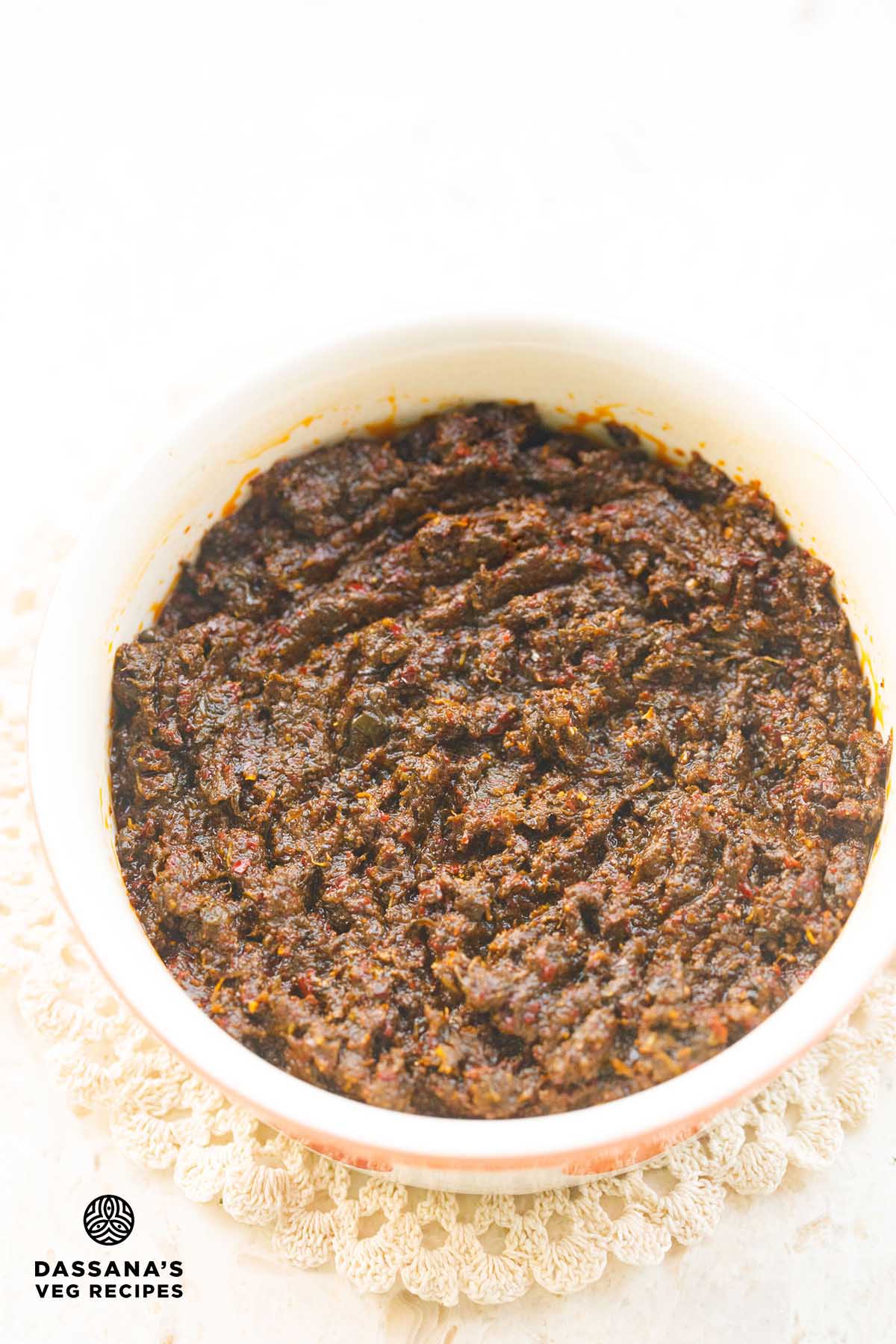

In Andhra delicacies, ‘gongura’ refers to sorrel leaves, scientifically often known as Hibiscus sabdariffa. Two major varieties are generally used:
- Crimson-stemmed gongura: Options darker inexperienced leaves with reddish stems and a pronounced sourness, usually favored in conventional recipes.
- Inexperienced-stemmed gongura: Lighter in shade, extra tender and barely much less tangy, but simply as conventional and extensively used, particularly when red-stemmed is just not accessible.
What I’m sharing here’s a Gongura Nilava Pachadi – a easy, bold-flavored model made with Sorrel (Hibiscus sabdariffa) referred to as Gongura in Telugu language.
Moreover, the phrase ’Nilava’ in Telugu means one thing that’s preserved or saved for an extended time. The time period ’Pachadi’ is a standard South Indian phrase for a spicy, tangy chutney or pickle.
A basic from Andhra and Telangana, this Sorrel Chutney is understood for its punchy style and lengthy shelf life. It has a tangy, spicy taste that pairs completely with scorching rice and a spoonful of ghee or sesame oil.
In actual fact gongura is a staple in Andhra households and finds its approach into chutneys (pachadi), dals and pickles.
The Gongura Pachadi, particularly, is understood for its daring, strong advanced flavors with refined bitter undertones. Whereas some name it a chutney and others a pickle, there are a lot of methods to organize this superior dish.
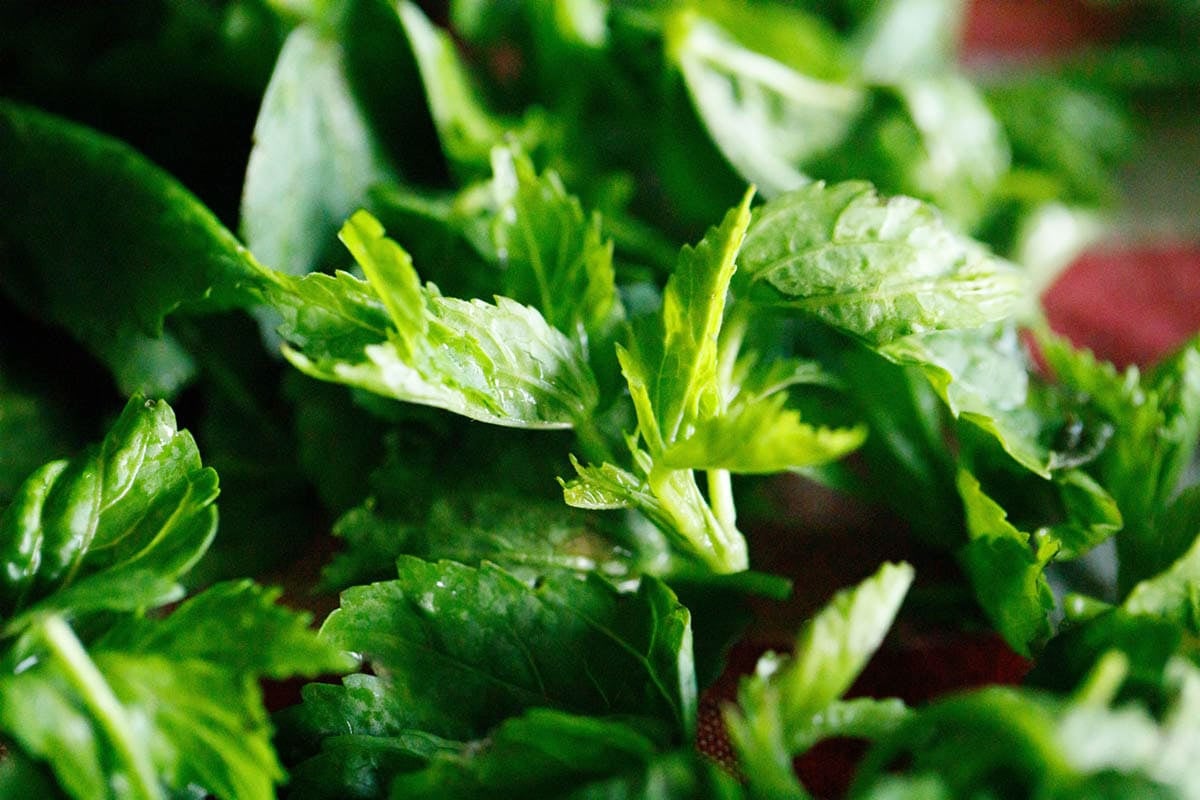

In my recipe, I’ve used green-stemmed gongura leaves, but it surely works simply as nicely with red-stemmed leaves. Be at liberty to make use of whichever selection is accessible to you. The purple selection offers a sharper tang, whereas the inexperienced brings a milder taste.
My model additionally makes use of minimal oil, making it a lighter choice that also retains nicely for a number of weeks. For those who plan to make a bigger batch or retailer the Gongura Pachadi longer, you possibly can enhance the oil amount to assist protect it.
Step-by-Step Information
Tips on how to make Gongura Pachadi
Prep & Sauté Sorrel Leaves
1. Pluck leaves from stems. You need to get 6 cups of gongura leaves. Rinse the leaves very nicely in water to take away any dust or grit. Drain further water from the rinsed leaves and dry the leaves.
Unfold them on a clear fabric for drying. Don’t dry in daylight. Dry in shade or in your kitchen. Drying takes a number of hours.
It is very important dry leaves in order that any further water doesn’t come into the pachadi. This may spoil it additional. The leaves shouldn’t be moist or moist.


2. Warmth ¼ cup oil in a kadai or sauté pan. Add the 6 cups of gongura leaves.
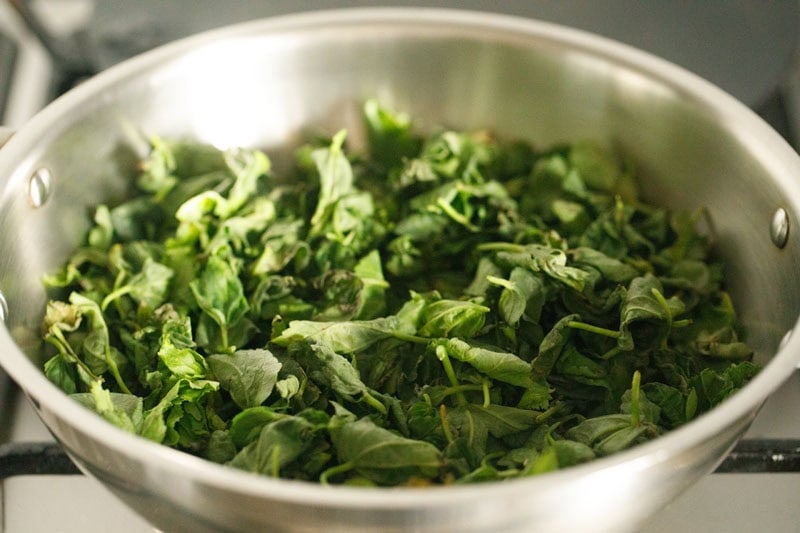

3. Combine and start to sauté, stirring usually.


4. First, the leaves will wilt. Proceed to sauté till oil separates on the sides. The cooking time for the leaves will vary from 10 to 12 minutes on a low to medium-low warmth.


5. Set the sautéed leaves apart on a plate to chill.


Mood Spices
6. Warmth 2 tablespoons oil in one other pan or identical pan.
Add 1 teaspoon mustard seeds. Once they crackle, flip off the warmth.
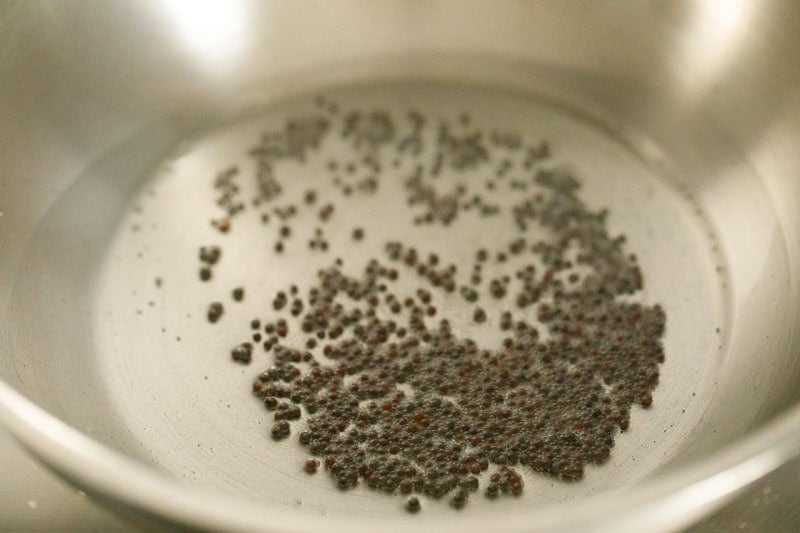

7. Add ½ teaspoon fenugreek seeds and ½ teaspoon asafoetida. Stir to combine and let the fenugreek seeds change shade.
Be certain that the seeds are fried nicely and don’t burn or get browned an excessive amount of.
Notice: If the fenugreek seed stay uncooked or are browned an excessive amount of or get burnt, then they style bitter.
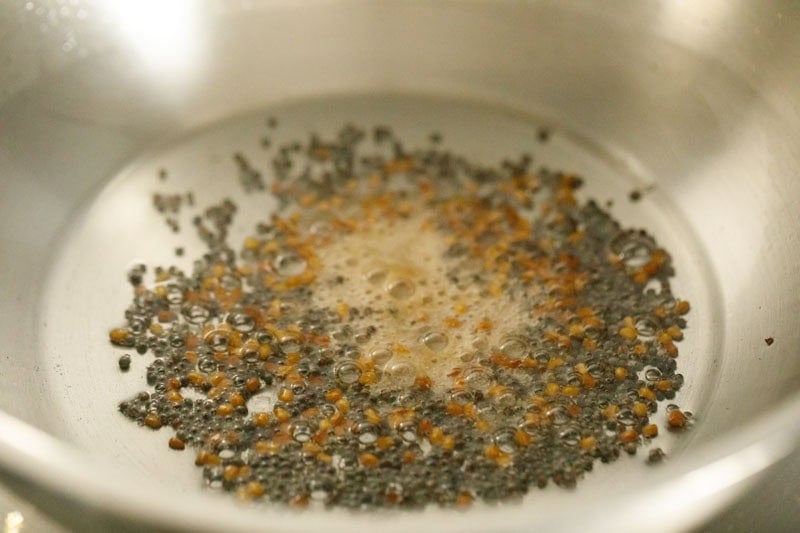

8. Add 7 to eight medium-sized Kashmiri dried purple chilies (I used 5 large-sized) and a couple of sprigs curry leaves (or 30 small curry leaves), and blend.
Tip: Halve or break and take away seeds from the purple chillies earlier than utilizing them.
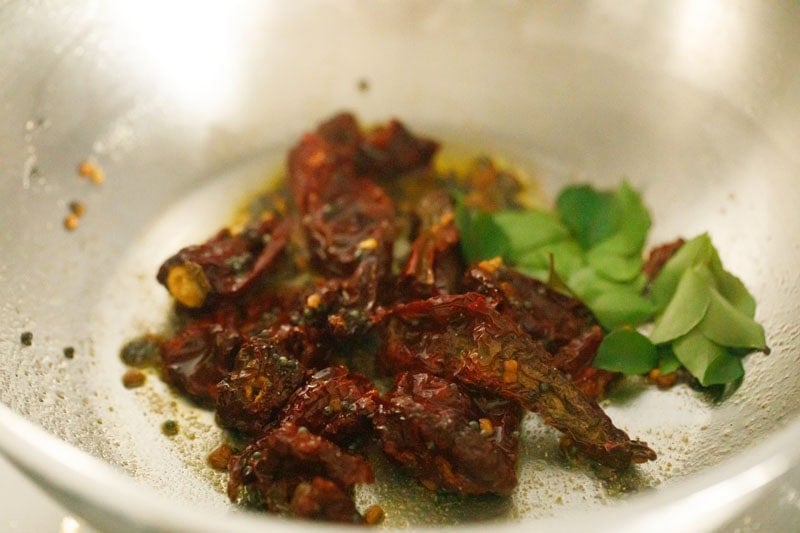

9. Activate the warmth and preserve it to a low. Stir usually, till purple chilies change shade and look crisp.
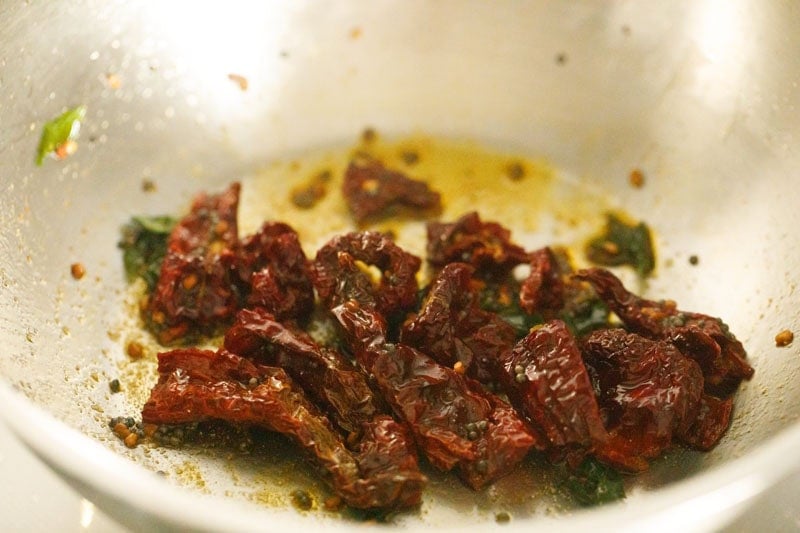

10. Flip off the warmth once more. Add ¼ teaspoon turmeric powder and blend.
Put aside this tempered spices combination to chill on a separate plate.
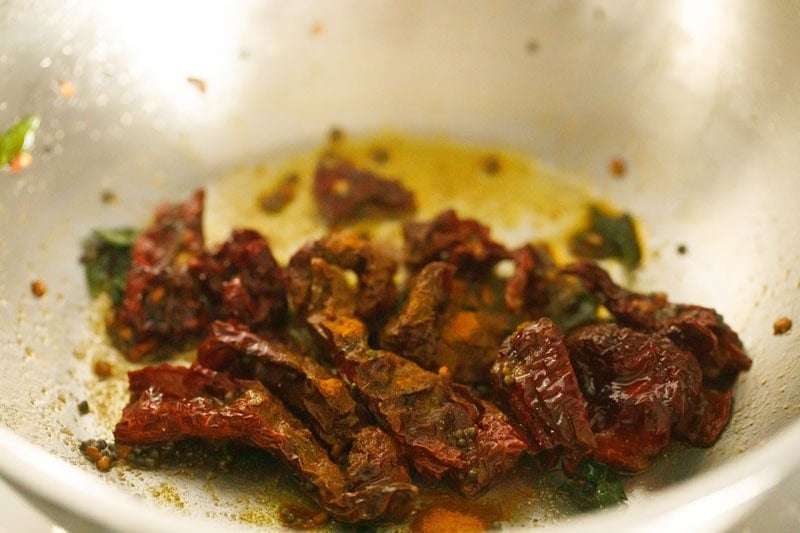

Make Gongura Pachadi
11. Switch to a mixer-grinder. Add ½ teaspoon pink salt or common salt in response to style.
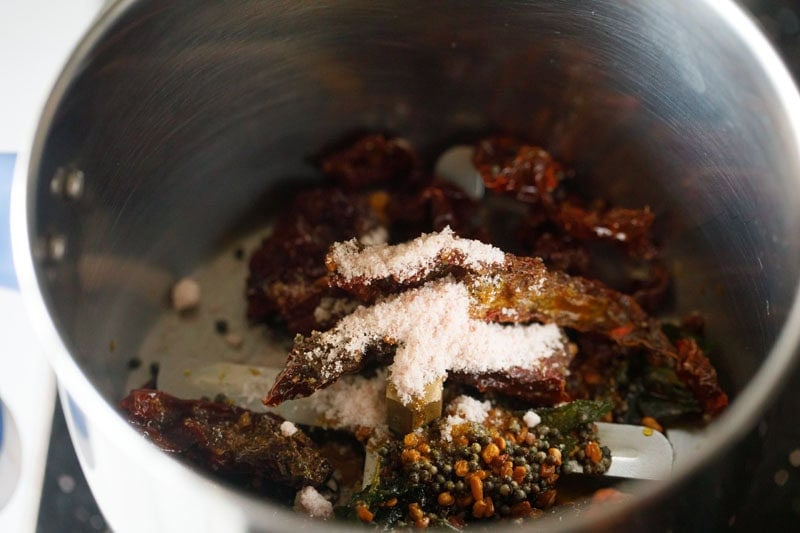

12. Grind to a rough combination.
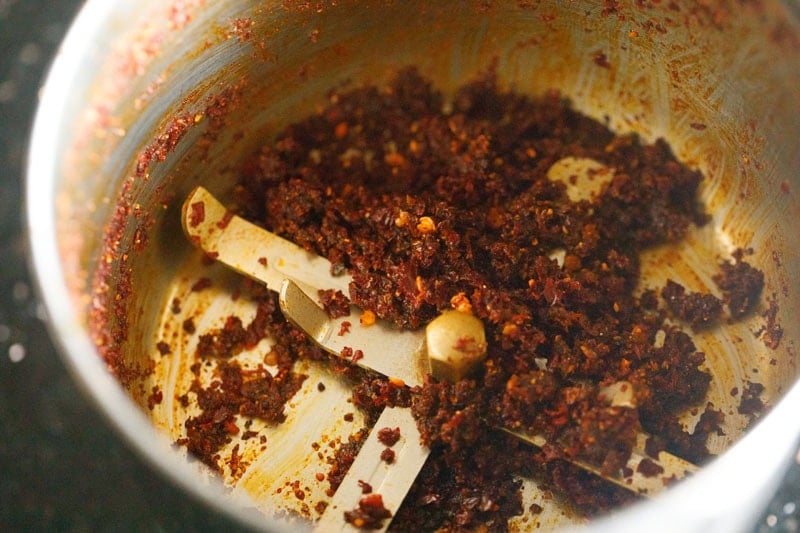

13. Add the sautéed gongura leaves along with any further oil that has remained after sautéing them.
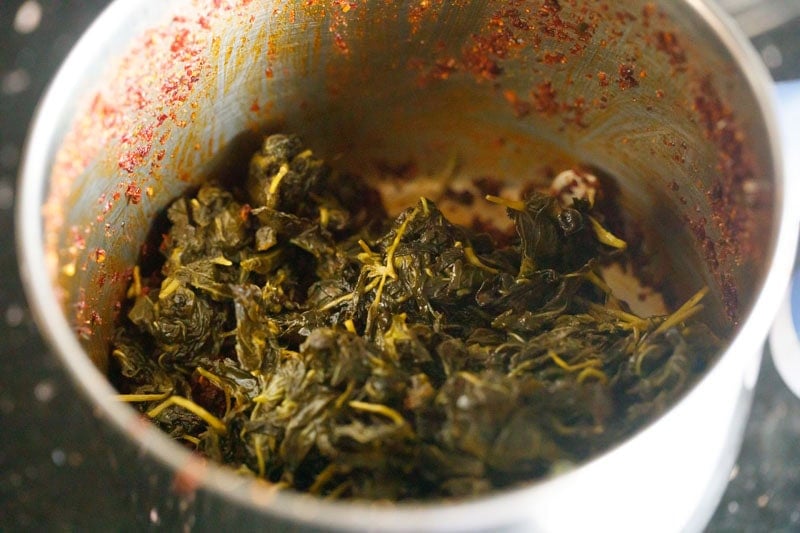

14. Pulse or grind in small bursts to a rough or semi-coarse texture.
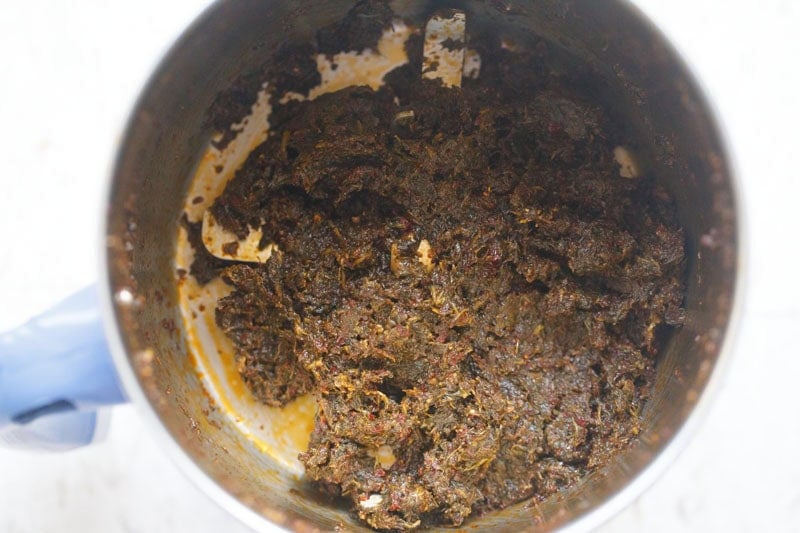

15. Switch Gongura Pachadi to a clear bowl or jar. Maintain it air-tight and sealed with a lid.
Tip: Keep away from storing in steel containers or bowls, because the sourness of gongura might react with them.
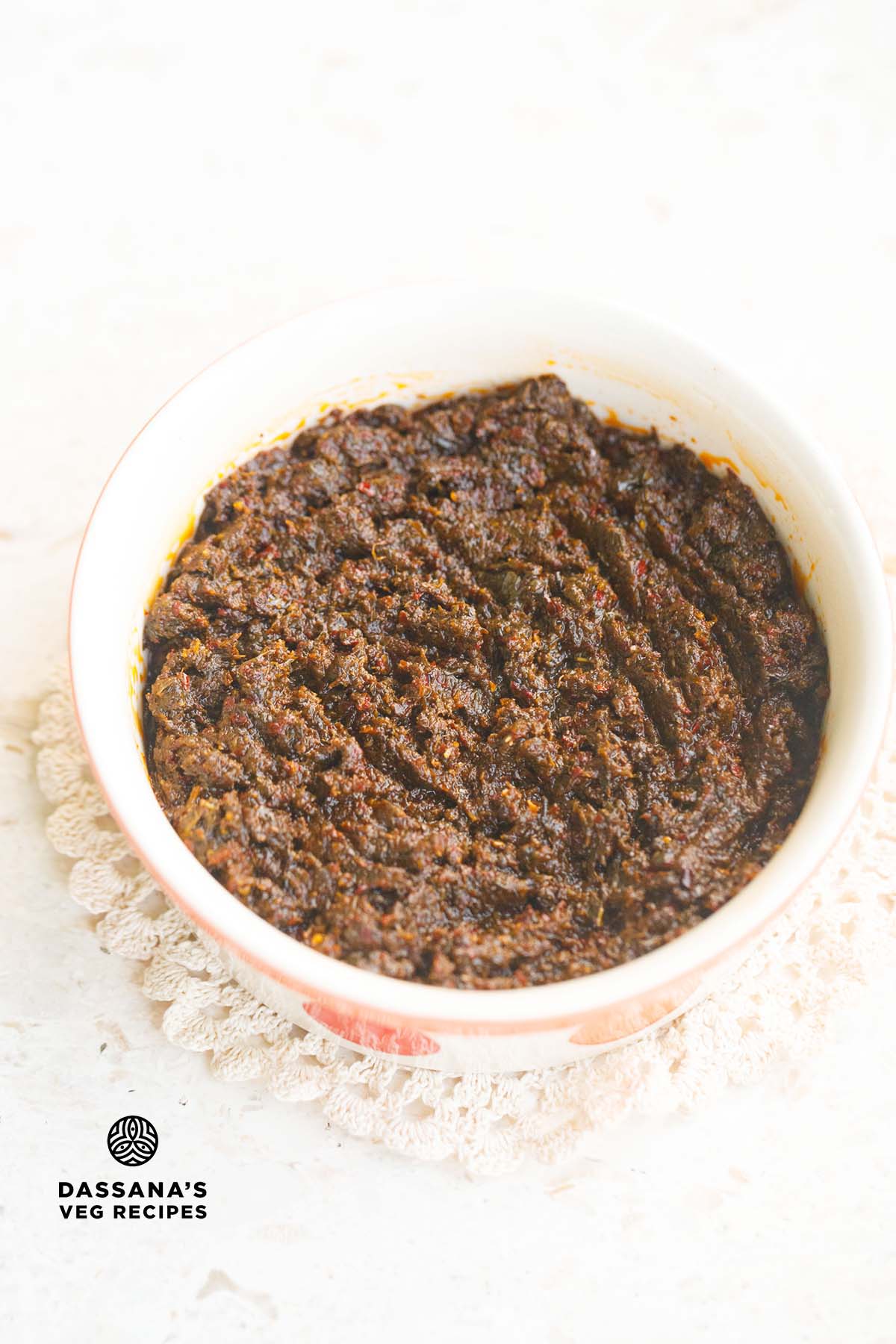

Storage & Serving Strategies
Refrigerate the bowl or jar with the pachadi and use it as wanted. When eradicating the pachadi, use a clear dry spoon. The pachadi retains nicely for about a number of weeks when refrigerated.
If you wish to retailer for an extended time frame, freeze the chutney in small parts. Thaw it earlier than utilizing.
Gongura Pachadi is finest loved as a aspect dish or blended into scorching steamed rice. It additionally pairs nicely with chapati.
You possibly can serve it alongside South Indian meals like Sambar, dal or Rasam with rice. It’s equally scrumptious when accompanied by Curd Rice for a tangy-spicy distinction.
Professional Ideas
- Tempering choices: For further taste, in a little bit of oil, mood mustard seeds, curry leaves and a pinch of asafoetida (hing) and add this tempering to the ready chutney.
- Add crunch with lentils: You might embrace urad dal or chana dal within the tempering for a refined crunch and nuttiness.
- Regulate chilli for warmth: Customise the spice degree by growing or lowering the variety of purple chilies based mostly on their pungency and warmth.
- Use of Kashmiri chilies: Kashmiri purple chilies provide vibrant shade with milder warmth. Use 5 to six medium-sized chillies, should you choose a much less spicy chutney. You might additionally embrace a number of inexperienced chillies, should you like.
- Stability bitter & tangy notes: To mellow the bitterness of fenugreek seeds and tartness of sorrel, preserve the fenugreek seeds to simply ¼ teaspoon if utilizing fewer chillies.
- Together with tamarind: Decide so as to add a small piece of tamarind, for a extra pronounced bitter style or if the gongura leaves are much less our.
- Richer taste with garlic: For added depth whereas serving, fry some garlic and stir it into the chutney.
- Oil adjustment: Add extra oil should you choose a richer, extra pickle-like consistency.
- Non-obligatory substances: Curry leaves and turmeric could be skipped if desired – they’re elective additions.
FAQs
Sorrel leaves have a definite tangy and bitter style, with earthy and mildly bitter undertones. These advanced flavors makes it a standout ingredient in chutneys just like the Gongura Pachadi, pickles and curries.
Gongura is finest recognized for its use in Andhra delicacies, particularly within the iconic dish Gongura Pachadi. It’s additionally widespread in pickles and lends a novel sourness to dals and curries in South Indian cooking.
There are primarily 2 sorts of sorrel or gongura generally utilized in cooking:
– Crimson-stemmed gongura: extra bitter and most popular in conventional recipes
– Inexperienced-stemmed gongura: milder in tang and tender in texture
Gongura is botanically often known as Hibiscus sabdariffa and can also be known as sorrel leaves in English. In numerous Indian languages, it’s recognized by names like ‘pulicha keerai,’ ’ambadi’, ’pundi soppu’, or ‘pitwaa’.
Extra Pachadi Recipes To Attempt!
Please remember to price the recipe within the recipe card or depart a remark beneath if in case you have made it. For extra vegetarian inspirations, Signal Up for my emails or comply with me on Instagram, Youtube, Fb, Pinterest or Twitter.
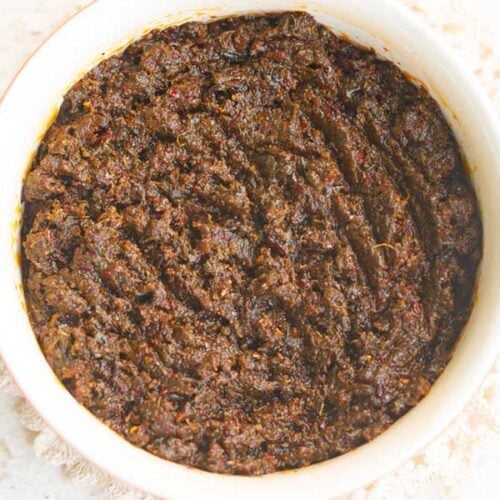

Gongura Pachadi Recipe (Andhra Type)
Gongura Pachadi is a spicy, tangy and flavorful chutney from Andhra delicacies, ready utilizing sorrel leaves (gongura/ambadi), purple chillies, curry leaves, fenugreek seeds, mustard seeds, oil and some floor spices. The leaves are sautéed and blended with roasted spices to create a daring, bitter, earthy and scrumptious chutney.
Prep Time 20 minutes
Cook dinner Time 15 minutes
Complete Time 35 minutes
Stop your display screen from going darkish whereas making the recipe
Sauté Substances
Warmth ¼ cup oil in a pan.
Add the dried gongura leaves and sauté. The leaves will first wilt, then slowly launch moisture.
- Proceed sautéing till the oil begins to separate and leaves are well-cooked.The cooking time for the leaves will range from 10 to 12 minutes on a low to medium-low warmth.
Put aside and let the sautéed leaves cool.
Mood Spices
Warmth 2 tablespoons oil in the identical pan or in one other pan.
Add mustard seeds. Once they start to crackle, flip off the warmth.
Add fenugreek seeds and asafoetida. Combine gently and let the fenugreek change shade barely.
Add dry purple chillies and curry leaves. Flip the warmth again on to low and sauté, stirring usually, till the chillies flip crisp and changer shade to a barely darker purple.
Flip off the warmth. Add turmeric powder and blend. Let this tempering cool utterly.
Make Gongura Pachadi
Switch the cooled tempering combination to a mixer-grinder. Grind to a rough powder.
Add the sautéed gongura leaves together with any oil remaining within the pan. Add salt.
Pulse or grind in brief bursts till you get a rough or semi-coarse texture.
Switch to a clear, dry glass jar or a ceramic bowl.
Storage
Refrigerate the pachadi in air-tight glass or ceramic bowl or jar and use as wanted.
At all times use a clear, dry spoon when serving to take care of shelf life. It retains nicely for about a number of weeks when refrigerated.
Serving Strategies
Serve Gongura Pachadi with scorching steamed rice with a light-weight drizzle of ghee or sesame oil.
The spicy and bitter flavors of Gongura Chutney additionally pairs nicely with curd rice or sambar, rasam and plain dal with steamed rice.
It can be loved as a aspect with idli, dosa, or chapati.
- Crimson Chillies: Regulate the dried purple chillies based mostly on their warmth. I used Kashmiri chillies for gentle warmth and shade. Use 5 to six medium-sized Kashmiri chillies for much less spice or extra for a spicier pickle. However observe that the spiciness and the warmth from the chillies, balances the tartness of gongura and the bitterness of fenugreek. Therefore cut back fenugreek to ¼ teaspoon if utilizing fewer chillies.
- Non-obligatory Substances: Curry leaves and turmeric are elective.
- Together with Garlic: For further taste, fry garlic and blend with the pachadi earlier than serving.
- Second Tempering (Non-obligatory): For added taste, mustard seeds, curry leaves, hing, urad dal, or chana dal could be fried in a little bit of oil and blended into the ready pachadi.
- Oil: Add extra oil if desired, particularly for longer shelf life. You should utilize sesame oil (gingelly oil) for genuine taste, or substitute with sunflower or peanut oil – each work nicely on this recipe.
Diet Details
Gongura Pachadi Recipe (Andhra Type)
Quantity Per Serving
Energy 140 Energy from Fats 126
% Every day Worth*
Fats 14g22%
Saturated Fats 1g6%
Polyunsaturated Fats 1g
Monounsaturated Fats 12g
Sodium 197mg9%
Potassium 20mg1%
Carbohydrates 2g1%
Fiber 1g4%
Sugar 0.3g0%
Protein 1g2%
Vitamin A 1381IU28%
Vitamin B1 (Thiamine) 0.01mg1%
Vitamin B2 (Riboflavin) 0.01mg1%
Vitamin B3 (Niacin) 8mg40%
Vitamin B6 0.01mg1%
Vitamin C 38mg46%
Vitamin E 6mg40%
Vitamin Ok 1µg1%
Calcium 6mg1%
Vitamin B9 (Folate) 155µg39%
Iron 1mg6%
Magnesium 55mg14%
Phosphorus 7mg1%
Zinc 0.1mg1%
* % Every day Values are based mostly on a 2000 calorie food regimen.

